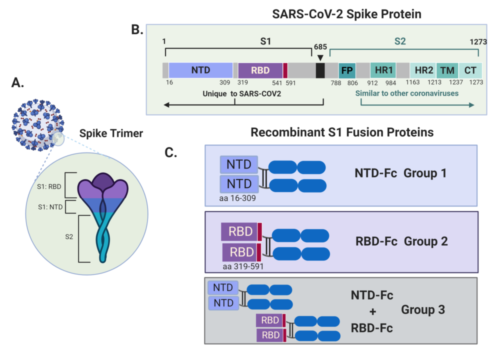New study from Intuitive Biosciences uses CSA assays to monitor candidate vaccine efficacy in nonhuman primate model for SARS-CoV-2.
“A recombinant protein SARS-CoV-2 candidate vaccine elicits high-titer neutralizing antibodies in macaques.”
Gary Baisa, David Rancour, Keith Mansfield, Monika Burns, Lori Martin, Daise Cunha, Jessica Fischer,
Frauke Muecksch, Theodora Hatziioannou, Paul D. Bieniasz, Fritz Schomburg, Kimberly Luke*
*corresponding author: kluke@intuitivebio.com
Vaccines that generate robust and long-lived protective immunity against SARS-CoV-2 infection are urgently required. We assessed the potential of vaccine candidates based on the SARS-CoV-2 spike in cynomolgus macaques (M. fascicularis) by examining their ability to generate spike binding antibodies with neutralizing activity. Antigens were derived from two distinct regions of the spike S1 subunit, either the N-terminal domain (NTD) or an extended C-terminal domain containing the receptor-binding domain (RBD) and were fused to the human IgG1 Fc domain. Three groups of 2 animals each were immunized with either antigen, alone or in combination. The development of antibody responses was evaluated through 20 weeks post-immunization. A robust IgG response to the spike protein was detected as early as 2 weeks after immunization with either protein and maintained for over 20 weeks. Sera from animals immunized with antigens derived from the RBD were able to prevent binding of soluble spike proteins to the ACE2 receptor, shown by in vitro binding assays, while sera from animals immunized with the NTD alone lacked this activity. Crucially, sera from animals immunized with the RBD but not the NTD had potent neutralizing activity against SARS-CoV-2 pseudotyped virus, with titers in excess of 10,000, greatly exceeding that typically found in convalescent humans. Neutralizing activity persisted for more than 20 weeks. These data support the utility of spike subunit-based antigens as a vaccine for use in humans.
Abstract
Vaccines that generate robust and long-lived protective immunity against SARS-CoV-2 infection are urgently required. We assessed the potential of vaccine candidates based on the SARS-CoV-2 spike in cynomolgus macaques (M. fascicularis) by examining their ability to generate spike binding antibodies with neutralizing activity. Antigens were derived from two distinct regions of the spike S1 subunit, either the N-terminal domain (NTD) or an extended C-terminal domain containing the receptor-binding domain (RBD) and were fused to the human IgG1 Fc domain. Three groups of 2 animals each were immunized with either antigen, alone or in combination. The development of antibody responses was evaluated through 20 weeks post-immunization. A robust IgG response to the spike protein was detected as early as 2 weeks after immunization with either protein and maintained for over 20 weeks. Sera from animals immunized with antigens derived from the RBD were able to prevent binding of soluble spike proteins to the ACE2 receptor, shown by in vitro binding assays, while sera from animals immunized with the NTD alone lacked this activity. Crucially, sera from animals immunized with the RBD but not the NTD had potent neutralizing activity against SARS-CoV-2 pseudotyped virus, with titers in excess of 10,000, greatly exceeding that typically found in convalescent humans. Neutralizing activity persisted for more than 20 weeks. These data support the utility of spike subunit-based antigens as a vaccine for use in humans.

